Yamaha Three-Cylinder Cross-Plane Concept
By Kevin Ash - 05/10/2012
Yamaha has intrigued the bike world with the unveiling of a prototype three-cylinder engine at Cologne, sparking some wild speculation by saying it comes with a cross-plane crankshaft.
The point of a cross-plane crank is covered in detail in this feature here:
Yamaha R1 cross-plane crankshaft feature
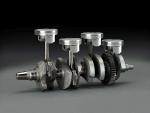
In brief, the principle is to minimise the rotational fluctuations of the crankshaft caused by the pistons' reciprocating movement. In a conventional four-cylinder engine, at one point all four pistons are stationary, then as the crank rotates through 90 degrees, all four have accelerated to their maximum speed. 90 degrees further on again, all four are stationary once more.
This means a big change in piston inertia, from zero to maximum to zero every half turn of the crankshaft, which is constantly being transferred to and from the crankshaft. For example, when the pistons are slowing down, they're doing so by pushing against the crank, which in turn speeds up. Then as the pistons accelerate from TDC and BDC to maximum speed halfway along the bores, they're gaining inertia from the crankshaft which is pushing them, and the crank slows down.
These cyclic torque fluctuations are large in scale, in a four-cylinder superbike engine they can be of the order of plus and minus 600lb.ft (80kgm, 800Nm). This feature gives an idea of how the numbers are arrived at:
Inertial torque scale calculation feature
This is inherent in the conventional flat plane crankshaft-piston system and is proportional to the rpm, while the torque generated by combustion is overlaid on top of that. The two are referred to as combustion torque and inertial torque.
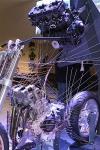
In a cross-plane four-cylinder the pistons are spaced 90 degrees apart, so there is no point at which they are all stopped or moving at the same speed together. The inertial gains of any one piston are always being cancelled out by the inertial losses of another, resulting in an even rotation speed of the crankshaft, free of inertial torque fluctuations.
Yamaha says this results in a more direct feeling for the rider, in part because whenever he opens the throttle he gets only the combustion torque, without the large inertial torque fluctuations clouding the output, and in part because there is no need for a driveline cushion (such as the springs you see in embedded in many clutch back plates) to protect the gearbox from inertial torque vibration - this also filters out feedback to the rider.
How could this be achieved in a three-cylinder engine? Yamaha has given us a clue, describing the new engine as having a cross-plane crank. Senior executive Kunihiko Miwa also said "...this means the kind of torque character that gives riders the exact torque they want when they need it," confirming the new engine will have zero inertial torque, as it's the same language used for the cross-plane R1. This rules out conventional 120 degree crank throws, which would hardly be innovative anyway as every other triple bar early Laverda Jotas uses this layout. The Jota had 180 degree crank throws, simply because its engine was a twin with an extra cylinder grafted on and Laverda only had the tooling to do it this way.

In the Yamaha three-cylinder, cross-plane design there are two possibilities. Either the two outer pistons move up and down together, with the third following at 270 degrees, or the outer two are set at 180 degrees apart, with the centre piston at 90 degrees between them, in effect an R1 crankshaft with the end cylinder removed, an idea that fits in with Yamaha's Cologne display where the link to the R1 and cross-plane M1 MotoGP engine was made.
This is easy enough to balance, but the problem is, the inertial torque is a long way from being zero. In fact the fluctuations are similar to a single-cylinder engine of the same capacity as one of the Yamaha's three cylinders. The solution though could be with us already in a very different Yamaha, the T-Max.
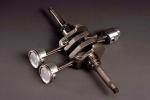
This is a parallel twin balanced by a slave piston set at 180 degrees to the cylinders. Inertial torque is at its maximum in this design but it doesn't matter, as throttle response is dulled anyway by the auto transmission. But it does show how the Yamaha three-cylinder cross-plane crank could be made to have zero inertial torque. In this, the fourth, slave piston's inertia works with the centre piston's in cancelling out the inertia of the other two. Do note this is inertia we're talking about, not out-of-balance forces, although it can cancel some of those too.
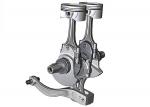
There are alternatives producing the same fundamental result of zero inertial torque in the three-cylinder plus reciprocating balancer layout. One is to use instead of the slave piston a bobweight counterbalance like that in BMW's F800 twin:
BMW Reciprocating Engine Balancer feature
This is bulkier than the slave piston design but it has lower friction levels and offers additional horizontal motion components which can be carefully designed to help counterbalance vibration.
But I'm betting on a final option as it's the most elegant, lightest, lowest cost and results in a stiffer crankshaft. This still involves a fourth conrod, but rather than have its own crankpin it runs on the same crankpin as the centre cylinder (like a V-twin). This means the slave piston (or counterbalance bobweight) moves in the same rather than the opposite direction to the centre cylinder piston. At the same time, the outer two pistons would also move up and down together, firing at 360 degree intervals. Inertial torque levels are still zero (or strictly speaking, very close to zero, as in the R1), as the two pairs of pistons are moving 90 degrees out of phase with each other, but there are now large out-of-balance forces. These though are easy to counter, using a contra-rotating balance shaft in front of or behind the crank. The advantage of this design is it leaves room for a crankshaft bearing between each cylinder, a much stiffer design better suited to high revs and power outputs.
As with the R1, the exhaust note would be unique and appealingly gruff and offbeat, with possible firing intervals at 360-90-270 degrees. By comparison, the R1 has 270-180-90-180 degree intervals, showing that Yamaha is not shy of using overlapping combustion cycles just 90 degrees apart.
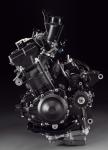
This all fits with the aim of cancelling inertial torque and also draws on existing Yamaha technology while moving it forward in an innovative way, exactly as the company wishes to do. There are some visual clues in the engine itself which appear to confirm these possibilities. One is the deep and bulky sump design in an otherwise very compact engine, which offers plenty of space for either a slave piston or a counter-balance bobweight. Compare this with the R1 sump, which you might expect to be larger yet it's more compact.
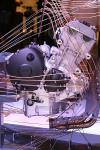
Secondly, there is very clearly a housing for a rotating balance shaft in front of the crankshaft. This is also sometimes used on conventional triples so it's not proof in itself, but the final 360 degree cross-plane design must have this, so without it the idea would be scuppered. It's bulky too, as you need to counter the primary out-of-balance forces in this design. The last clue isn't completely clear but it does look as if the spacing between cylinders one and two (numbered from left to right) is slightly greater than between two and three, which would be the case if the centre crankpin was wider and shared by two conrods.

This is all entirely speculation based on Yamaha's existing technology and the handful of clues from Miwa, along with external views of the engine itself. But it does fit, where a great deal of the commentary elsewhere is plainly wrong. For example, the 120 degree layout which many are suggesting does not constitute a cross-plane crankshaft. Cross-plane means lines drawn through the crankpin and crankshaft centres must form a cross when viewed from the end of the crank (which usually is inferred to mean with 90 degree angles), as is the case here. A 120 degree design forms three lines at 120 degrees to each other, which might resonate with Yamaha's triple tuning fork logo, but it's not cross-plane.
It looks like we'll find out for certain in the first half of 2013.
Donate to the Kevin Ash Fund
Kevin's funeral was held on Thursday 28th February 2013 and was well attended by family, friends and colleagues.
The Telegraph has very kindly established The Telegraph Kevin Ash Fund to assist with the education of Kevin's three daughters.
If you'd like to make a donation then you can use the PayPal 'Donate' button below which will allow you to donate from your PayPal account, or via credit or debit card. A small percentage (about 3.4%) will be retained by PayPal for the service.
Kevin's family have been touched by the generosity and messages of support from people using the website and would like to express their gratitude to those who have contributed in any way.
The donations keep coming in, thank you so much, and the family especially like it when you leave a message.
Home | ![]() facebook.com/KevinAshFund
|
facebook.com/KevinAshFund
| ![]() twitter.com/KevinAshFund | © 2012
twitter.com/KevinAshFund | © 2012